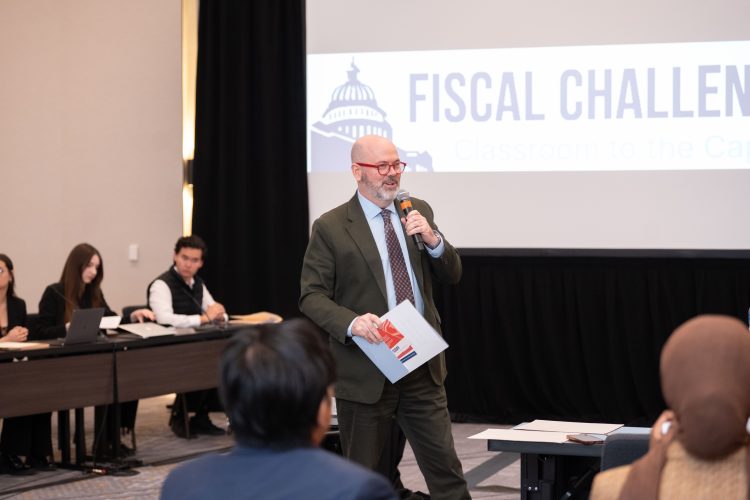I. Introduction
I. Introduction
The House and Senate each moved forward last week on slightly different Fiscal Year 2008 budget plans. The good news is that Budget Committee Chairmen John Spratt (D-SC) and Kent Conrad (D-ND) fought off all attempts to eliminate or waive the new pay-as-you-go (paygo) rules that are crucial to making their respective fiscal blueprints work.
The bad news is that neither plan calls for any attempt to rein in the unsustainable long-term spending growth already embedded in current programs.
Moreover, in an indication of how difficult it may be to ultimately hold the line on paygo, senators could not resist laying claim to the $132 billion surplus that the Senate Budget Committee (SBC) plan had projected for FY 2012. Most of this projected surplus was claimed for extending expiring tax breaks. A smaller amount was claimed for expansion of the State Childrens’ Health Insurance Program (SCHIP). The vote was almost unanimous at 97-1. Only Sen. Russell Feingold (D-Wis.) voted no. While paygo was not waived for these items, it is clear that future legislation affecting them will test the Senate’s resolve to strictly abide by paygo.
Table 1. Deficits
Meanwhile, the House Budget Committee (HBC) voted 22-17 along straight party lines March 21 to approve the plan drafted by Chairman John Spratt (D-SC). The full House is scheduled to debate the budget resolution beginning Wednesday, March 28. In general, the House plan follows the contours of the Senate plan. This similarity heightens the chances that the two branches will be able to agree on a joint congressional budget resolution when they return from their Spring recess, which begins at the end of this week.
II. Highlights of the House Budget Committee’s Budget Resolution
The HBC plan projects a deficit of $213 billion in FY 2008, followed by an increase in FY 2009 to $241 billion before shrinking to $205 billion in FY 2010 and to $50 billion in FY 2011, after the 2001 and 2003 tax cuts are set to expire. A surplus of $153 billion is projected in FY 2012. As a percentage of Gross Domestic Product (GDP), spending and debt would decline over the five-year period while revenues would increase.
In the HBC markup, Democrats turned back more than two dozen GOP-sponsored amendments, several of which would have extended expiring 2001 and 2003 tax cuts without the offsets required under recently approved House paygo rules.
An amendment by Rep. Jo Bonner (R-AL) to have paygo rules apply only to new entitlement spending, but not to tax cuts, was defeated on a 15-20 vote, with Rep. Michael Simpson (R-ID) voting with Democrats.
Democrats also blocked passage of GOP amendments to freeze or reduce discretionary spending levels or to include reconciliation instructions to trim entitlement spending.
In comparison with the President’s budget, as scored by the Congressional Budget Office (CBO), the HBC budget would average higher spending over the five-year period (19.8 percent of GDP vs.19.4 percent) and higher revenues (19.1 percent of GDP vs.18.4 percent). By 2012, revenues would be more than a full percentage point of GDP higher under the HBC plan than in the President’s budget (19.8 percent vs. 18.4 percent). Spending would not diverge by as much. Under the HBC plan, spending in 2012 would be 18.9 percent of GDP and in the President’s budget, spending would be 18.6 percent of GDP.
Table 2. Outlays
Table 3. Revenues
Passing the first test of paygo
Earlier this year, the new House Democratic leaders adopted a paygo rule for entitlement expansions and tax cuts. In a successful first test of how seriously they plan to abide by this rule, the HBC plan assumes no entitlement expansions or tax cuts that are not fully offset. Instead, all such initiatives are assigned to 12 deficit neutral reserve funds — including such politically popular items as: expansion of SCHIP, reauthorization of the farm program, relief from the Alternative Minimum Tax (AMT) and extension of many of the 2001 and 2003 tax cuts, which expire by 2011. Tapping these reserve funds would require offsets to pay for the new initiatives.
The next, and much more difficult test for paygo will be to design deficit neutral legislation implementing the budget resolution. It is vital to the plan’s success that paygo be applied across the board. If one exemption is granted, advocates of other interests will demand that their priorities be exempted as well. Were that to happen, fiscal discipline would quickly collapse. Moreover, if exemptions from the rule are carved out in either the House or Senate versions of the budget resolution, it will complicate efforts to negotiate a final joint congressional budget resolution. [1]
Discretionary spending
Like its Senate counterpart, The HBC plan rejects President Bush’s proposed funding cuts in domestic programs and instead increases funding for programs such as education, children’s health care, veterans care, training, and homeland security. In total, the House budget would spend $24 billion (including $2 billion available because of a new rule on advanced appropriations) above the president’s request for non-defense discretionary spending in FY 2008. That represents an increase of about 5.2 percent from 2007 levels.
It is notable that in the later years (2010-2012), when specific programmatic funding levels do not need to be specified as a result of this budget resolution, the budget assumes more restraint on nondefense discretionary spending than they show for next year—with an average increase of 2 percent, slightly below inflation. This “stronger-with-time” restraint is a common assumption in Washington budgeting, and one that normally proves too optimistic.
Defense spending tracks closely with the President’s request. The budget includes $145 billion for funding the wars in Iraq and Afghanistan for FY 2008. For FY 2009, only $50 billion is included, and there is no budget for any war spending in later years — a clearly unrealistic assumption that is shared by the President and the Senate.
Table 4. Discretionary Spending
Mandatory spending
In keeping with paygo, no expansions of mandatory spending programs are assumed in the HBC budget resolution. All such initiatives must have offsets that would either reduce other mandatory spending or raise revenues to pay for them. It is a particularly positive sign that the budget resolution applies this restriction to a number of high priority items for the Democratic leadership — such as expansion of the SCHIP program and reauthorization of the farm program. A paygo exemption for such items would signal that “fiscal discipline” applies only to extension of expiring tax cuts. As noted above, however, the real test will come when legislation is actually produced by the appropriate committees and considered on the House floor.
The HBC budget contains one reconciliation instruction, ordering the Committee on Education and Labor to report legislation by Sept. 10 to reduce the deficit by finding $75 million in savings from programs under its jurisdiction. There are no reconciliation instructions in the Senate plan.
The budget resolution rejects the President’s recommendations for savings in mandatory spending, many of which deserve bipartisan consideration. Even if paygo is strictly applied to expansions of mandatory programs, this would still leave spending growth under current law on an unsustainable path. Thus, treating the President’s proposals as “dead on arrival” is not enough. A complete strategy to restore fiscal discipline must include affirmative steps, beyond paygo, to achieve a sustainable long-term fiscal policy path. No such steps are included in the HBC budget resolution.
Revenues
There has been a great deal of confusion about how the paygo rule interacts with the revenues assumed in the budget resolution. In keeping with paygo, revenues in the HBC plan follow current law. Under current law, the tax cuts enacted in 2001 and 2003 are scheduled to expire on December 31, 2010. Moreover, current law does not assume further relief from the AMT. Thus, the revenue that comes from these provisions is assumed in the CBO baseline and, consequently, assumed in the HBC plan. It will take an act of Congress to change current law, and thus the revenue baseline.
The paygo provision in the budget resolution does not prevent any such action. It does require that the decision whether or not to extend these provisions be treated as a policy decision that requires a balancing of priorities and not simply assumed into the baseline.
Thus, to be clear, the budget resolution does not call for or require a tax increase. For example, no instructions are given to the House Ways and Means Committee to raise revenues. Any tax increases said to be contained in the HBC plan are the result of current law “sunsets” that were included when these tax cuts were originally enacted, to avoid the level of fiscal scrutiny that the restored paygo rule is designed to ensure. Reserve funds in the HBC plan authorize future tax relief, but require that the legislation implementing it comply with paygo. This may be accomplished by finding offsetting revenues elsewhere or by reducing mandatory spending. Going through this process would force an explicit trade-off between spending, taxes and debt, which is exactly the priority setting exercise that the budget process should be.
III. Concord Coalition Perspective
The HBC plan contains several positive attributes supported by The Concord Coalition.
Specifically it would:
- Establish budget balance (or surplus) as its fiscal policy goal. This is the most appropriate goal given the known fiscal challenges that loom with the baby boomers’ retirement years (beginning in 2008). It is encouraging that the House Budget Committee, Senate Budget Committee and the Bush Administration are now on record in support of a balanced budget by 2012 ¾ although their plans for achieving that goal are still far apart.
- Adopt paygo rules for entitlement expansions and tax cuts. These simple rules played a crucial role in bringing the deficit under control in the 1990’s. Renewing them is the most important thing Congress can do in the short-term to prevent the long-term outlook from getting worse.
- Reject the administration’s practice of assuming permanent extension of certain expiring tax cuts in the baseline. The decision whether to remove the legislated sunsets for the tax cuts is a policy decision. It should be made through the legislative process, not by budget scorekeepers.
There are, however, aspects of the plan that are disappointing. Specifically, it does not:
- Budget for likely war costs. Like the President’s budget, the HBC plan assumes just $50 billion for the cost of military operations in Iraq and Afghanistan in 2009 and nothing in 2010 through 2012. Democrats have correctly noted in the past that this is an unrealistic assumption.
- Provide a meaningful spending reconciliation bill to achieve savings in entitlement programs. The explosion in health care and retirement benefits that looms on the horizon is the single biggest threat to our nation’s fiscal health. Including entitlement savings as a regular part of the annual budget process is an important step in addressing our long-term challenges. The President proposed some reforms in his budget, particularly with regard to Medicare, that merit inclusion in the congressional budget resolution. A more comprehensive approach to long-term fiscal policy may have to await the kind of formal bipartisan process that Senators Conrad and Judd Gregg (R-NH) have said they wish to establish. That is no reason, however, to avoid incremental steps that make sense on their own and that can achieve substantial savings.
IV. Senate Action — Did Someone Say “Surplus”?
After four days of floor debate, the Senate voted 52-47 on March 23 to pass an amended version of the budget blueprint that the SBC approved on a straight party line vote on March 15. Republican Senators Olympia Snowe and Susan Collins of Maine broke with GOP colleagues to join united Democrats in backing the SBC budget plan.
The Senate approved the budget resolution after passing approximately three dozen amendments, many on voice votes. Most of the unanimously approved changes appear to be either non-controversial provisions or language that Budget Committee Chairman Conrad agreed to accept on the floor to move the lengthy process along but which may be dropped in conference with the House.
One amendment sponsored by Senate Finance Committee Chairman Max Baucus (D-MT) had, by far, the most significant impact. The purpose of the amendment was to commit the budget’s projected FY 2012 surplus of $132 billion to extending a series of expiring tax cut and to help fund an expansion of the SCHIP program.
The tax breaks mentioned by Baucus as fitting within his amendment include the $1,000 per-child tax credit, “marriage penalty” relief, the 10 percent tax bracket, an adoption tax credit, and an adoption tax credit. Those tax breaks and others adopted in 2001 and 2003 expire on Dec. 31, 2010, under current law.
The Baucus amendment also would make room for legislation to set a $3.5 million per person exemption from the estate tax ($7 million per married couple) and set a top tax rate of 45 percent. Under current law, the estate tax is scheduled to expire completely in 2010 before reverting to pre-2001 tax cut levels on Jan. 1, 2011 (an exemption of $675,000 and a top rate of 60 percent).
The Baucus amendment raises several troubling issues. For one thing, it seems to indicate that Members of the Senate have already forgotten the dangers of committing a projected surplus to pay for popular policies. In fact, if legislation were to be enacted in keeping with the intent of the Baucus amendment it would actually do more than commit the projected surplus. When interest costs from higher debt (or lower surplus) is accounted for it appears that the Baucus amendment would produce a small FY 2012 deficit.
In approving this amendment, the Senate lowered its projected revenues for the years 2010, 2011 and 2012. It also added 15 billion over the same three years for SCHIP. These adjustments are clearly inconsistent with paygo, and yet nothing in the Baucus amendment or elsewhere in the budget resolution waives paygo. The Baucus amendment thus produces an anomaly in the Senate Budget resolution’s numbers.
Another amendment of note was sponsored by Sen. Gordon Smith (R-OR), and co-sponsored by Sen. Edward Kennedy (D-MA), among others. It calls for raising the tobacco tax from the current 39 cents per pack to about $1 per pack and using the roughly $30 billion raised to provide coverage to millions more uninsured children under the SCHIP program. The amendment passed on a bipartisan 59-40 vote.
A string of GOP-sponsored amendments to extend other expiring tax cuts without the offsets needed to maintain deficit neutrality all were defeated, mostly along party lines. The Senate also defeated GOP attempts to cut discretionary spending levels – a move opposed by many senior GOP appropriators — and to include reconciliation instructions to Senate authorizing committees ordering them to trim entitlement programs by a total of $33.8 billion.
An amendment by Sen. Jim Bunning (R-KY) to set up a deficit neutral reserve fund to pay for the repeal of the 1993 tax increase on wealthier Social Security recipients passed on a voice vote. But use of the reserve fund approach means Congress could only repeal the increase if lawmakers could find the offsets needed to keep deficits from rising. With or without offsets, however, repeal of the 1993 tax increase on Social Security benefits would be a step in the wrong direction. Those revenues are dedicated to Social Security, which is already under funded over the long-term. There is no reason to dig the hole deeper.
[1] See Joint Statement on the Need For Pay-As-You-Go Discipline, March 21, 2007 issued by The Concord Coalition, The Committee for a Responsible Federal Budget, the Center on Budget and Policy Priorities and the Committee for Economic Development.
Continue Reading











